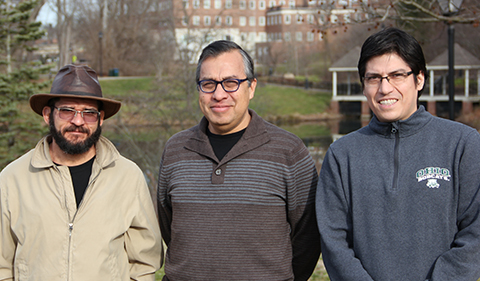By Ling Xin
NQPI Editorial Intern
Nanoscale and Quantum Phenomena Institute 2020 Spring Newsletter
A team led by Ohio University physicist Dr. Sergio Ulloa has used numerical simulations to study different mechanisms behind the behavior of long chains of magnetic impurities, which could be potentially useful in the transmission of quantum information.
Magnetic atoms pinned onto the surface of a usually non-magnetic metal, acting as impurities, can significantly change the host material’s properties under certain conditions. These atoms “talk to each other over a distance” through the spin of their electrons, and eventually line up to a state where all electron spins point to the same direction, said Ulloa, who is a member of NQPI. However, scientists have also discovered special cases in which magnetic atoms are not aligned in a parallel configuration but in different directions.
Ulloa and his former Ph.D. student Oscar Ávalos-Ovando, now a postdoctoral researcher at Ohio State University, explored the non-parallel alignment of magnetic impurities in transition metal dichalcogenides such as molybdenum disulfide (MoS2) and tungsten disulfide (WS2). They found that via the manipulation of key parameters, the electron spins of neighboring magnetic atoms slightly tilted to the side along the chain, resulting in a helix structure resembling a gradually twisted ribbon.
Understanding how such a structure forms is relevant for device applications, said Ulloa. Till today, we use electric currents for the transmission of information, and the loss of energy is significant as the electrons move along the way with multiple scatterings. If scientists can precisely control magnetic interactions on the atomic level, information can be transferred much more efficiently through the twists in a helix – as in the case of these spin chains.
In a more recent study, Ulloa and Ávalos-Ovando were joined by Edson Vernek, the 2020 OHIO Glidden Professor from the Federal University of Uberlandia in Brazil. As a continuation of previous studies, they examined the behavior of longer chains of magnetic impurities through computer simulations. Their research simulated chains made up of as many as 200 magnetic impurities, and found a critical point at which the tilted structure would quickly collapse, bringing about dramatic changes in the material’s physical properties such as the loss of magnetism.
By examining long chains, the new study made the system “as macroscopic as possible,” said Ulloa, shedding new light on lab experiments as well as possible practical applications. The next step of the research will go beyond the static scenario to look at the time evolution of the processes, namely how perturbations lead to changes in the structure over time.




















Comments